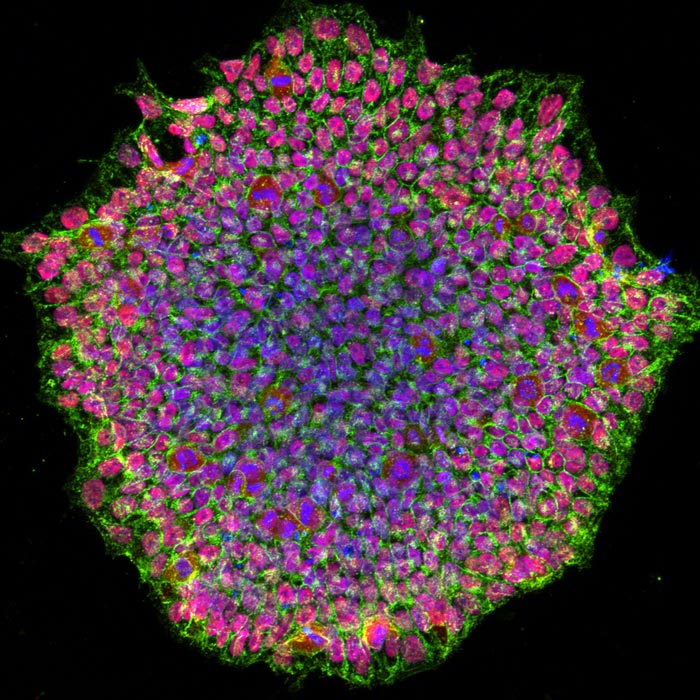First stem cell model of albinism to study related eye conditions

A human induced pluripotent stem cell colony from OCA1A patient. The image was acquired using a confocal microscope and is stained for pluripotency marker proteins. The red color depicts transcription factor OCT4, green is SSEA4 protein and blue represents the nucleus of the cells.
Credit: National Eye Institute (NEI)
Use of patient-derived stem cells will enable high-throughput drug screening for potential therapeutics.
The model’s development is described in the January issue of the journal Stem Cell Reports. NEI is part of the National Institutes of Health.
“This ‘disease-in-a-dish’ system will help us understand how the absence of pigment in albinism leads to abnormal development of the retina, optic nerve fibers, and other eye structures crucial for central vision,” said Aman George, Ph.D., a staff scientist in the NEI Ophthalmic Genetics and Visual Function Branch, and the lead author of the report.
OCA is a set of genetic conditions that affects pigmentation in the eye, skin, and hair due to mutation in the genes crucial to melanin pigment production. In the eye, pigment is present in the retinal pigment epithelium (RPE), and aids vision by preventing the scattering of light. The RPE is located right next to the eye’s light-sensing photoreceptors and provides them nourishment and support. People with OCA lack pigmented RPE and have an underdeveloped fovea, an area within the retina that is crucial for central vision. The optic nerve carries visual signals to the brain.
People with OCA have misrouted optic nerve fibers. Scientists think that RPE plays a role in forming these structures and want to understand how lack of pigment affects their development.
“Animals used to study albinism are less than ideal because they lack foveae,” said Brian P. Brooks, M.D., Ph.D., NEI clinical director and chief of the Ophthalmic Genetics and Visual Function Branch. “A human stem cell model that mimics the disease is an important step forward in understanding albinism and testing potential therapies to treat it.”
To make the model, researchers reprogrammed skin cells from individuals without OCA and people with the two most common types of OCA (OCA1A and OCA2) into pluripotent stem cells (iPSCs). The iPSCs were then differentiated to RPE cells. The RPE cells from OCA patients were identical to RPE cells from unaffected individuals but displayed significantly reduced pigmentation.
The researchers will use the model to study how lack of pigmentation affects RPE physiology and function. In theory, if fovea development is dependent on RPE pigmentation, and pigmentation can be somehow improved, vision defects associated with abnormal fovea development could be at least partially resolved, according to Brooks.
“Treating albinism at a very young age, perhaps even prenatally, when the eye’s structures are forming, would have the greatest chance of rescuing vision,” said Brooks. “In adults, benefits might be limited to improvements in photosensitivity, for example, but children may see more dramatic effects.”
The team is now exploring how to use their model for high-throughput screening of potential OCA therapies.
Publication:
Aman George, Ruchi Sharma, Tyler Pfister, Mones Abu-Asab, Nathan Hotaling, Devika
Bose, Charles DeYoung, Justin Chang, David R. Adams, Tiziana Cogliati, Kapil Bharti, Brian P. Brooks. In Vitro Disease Modeling of Oculocutaneous Albinism Type I and II Using Human Induced Pluripotent Stem Cell-Derived Retinal Pigment Epithelium (2022).
https://www.cell.com/stem-cell-reports/fulltext/S2213-6711(21)00597-X.
NEI leads the federal government’s research on the visual system and eye diseases. NEI supports basic and clinical science programs to develop sight-saving treatments and address special needs of people with vision loss. For more information, visit https://www.nei.nih.gov.
About the National Institutes of Health (NIH): NIH, the nation’s medical research agency, includes 27 Institutes and Centers and is a component of the U.S. Department of Health and Human Services. NIH is the primary federal agency conducting and supporting basic, clinical, and translational medical research, and is investigating the causes, treatments, and cures for both common and rare diseases. For more information about NIH and its programs, visit https://www.nih.gov/.
NIH…Turning Discovery Into Health®
Journal: Stem Cell Reports
DOI: 10.1016/j.stemcr.2021.11.016
Article Title: In Vitro Disease Modeling of Oculocutaneous Albinism Type I and II Using Human Induced Pluripotent Stem Cell-Derived Retinal Pigment Epithelium
Article Publication Date: 11-Jan-2022
Media Contact
Claudia Costabile
NIH/National Eye Institute
claudia.costabile@nih.gov
Office: 301-496-5248
All latest news from the category: Life Sciences and Chemistry
Articles and reports from the Life Sciences and chemistry area deal with applied and basic research into modern biology, chemistry and human medicine.
Valuable information can be found on a range of life sciences fields including bacteriology, biochemistry, bionics, bioinformatics, biophysics, biotechnology, genetics, geobotany, human biology, marine biology, microbiology, molecular biology, cellular biology, zoology, bioinorganic chemistry, microchemistry and environmental chemistry.
Newest articles

Security vulnerability in browser interface
… allows computer access via graphics card. Researchers at Graz University of Technology were successful with three different side-channel attacks on graphics cards via the WebGPU browser interface. The attacks…

A closer look at mechanochemistry
Ferdi Schüth and his team at the Max Planck Institut für Kohlenforschung in Mülheim/Germany have been studying the phenomena of mechanochemistry for several years. But what actually happens at the…

Severe Vulnerabilities Discovered in Software to Protect Internet Routing
A research team from the National Research Center for Applied Cybersecurity ATHENE led by Prof. Dr. Haya Schulmann has uncovered 18 vulnerabilities in crucial software components of Resource Public Key…





















